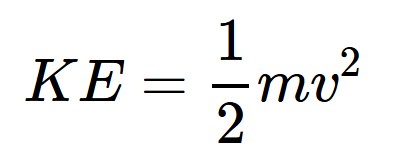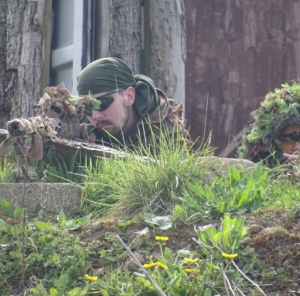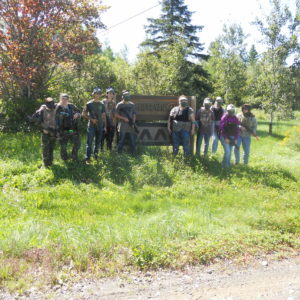Please note: it is important for the reader to understand that science is usually right, when the scientific method is right. As scientific methods evolve, our approximations move closer to truth and accuracy. The ability to self-correct is a hallmark of science, so if you want or need to dispute any scientific discovery, do so through the scientific method. Having done that, publish your findings and have them peer-reviewed, which lets other scientists try to prove you wrong.

A Brief History
Way back when airsoft first came into existence, there weren’t a lot of BB weight options. 0.20g BBs were the “norm”, and people were still using 0.12g BBs. But as more people got into airsoft, the sport began to change, as did the industry, to include bigger play areas, longer ranges and more consistent and accurate shots.
These days, most outdoor players run at least 0.32g BBs. Snipers and DMR players will run even heavier weights. 0.20g BBs are rarely used. 0.12g BBs are never used. However, the 0.20g standard remains; spring upgrades are the perfect example of this. That spring labeled M120 means that it was engineered to provide 120 meters per second with a 0.20g BB. Some springs still list their power as a percentage based on “standard Tokyo Marui” springs, which was about 300 fps with 0.20g BBs, or around 0.84 joules.
This sport has progressed a lot in the past few decades as we’ve learned more about the systems involved. This is a Good Thing™.
People can understandably be reluctant to change and adapt to new information. And the people who really need to most read this post and understand it will not because there are no hit markers or memes or bloody face injuries. These are most likely the same people who didn’t pay attention in science class because “we’re never gonna have to use this shit in life”. However, this post is here until the world ends, so at any time someone wants a little enlightenment, they can come hang out.
An unhealthy number of players still think that more FPS means more range. In all reality though, the speed (or velocity) is only a part of the equation. Literally. The mass (weight) of the BB is the other important part. With these two known factors, we can calculate the kinetic energy of our BB, which is measured in joules. The kinetic energy of the BB is the important factor because we can accurately predict how far that BB will travel, and how much force it will impact a target within its range.
 Before we break out our trusty calculator watches, we need to understand a few more things. Yup. Story time again.
Before we break out our trusty calculator watches, we need to understand a few more things. Yup. Story time again.
Classical Mechanics
Classical Mechanics is a physical theory describing the motion of macroscopic objects, from projectiles to parts of machinery and astronomical objects, such as spacecraft, planets, stars, and galaxies. For objects governed by classical mechanics, if the present state is known, it is possible to predict how it will move in the future (determinism), and how it has moved in the past (reversibility). (Source: Encyclopedia Britannica)
Yup. Those are all words. But what does that mean?
Here you go:
Classical Mechanics is a physical theory describing the motion of BBs and being able to predict what range I can get out of my airsoft gun. (Source: me, using critical thinking)
Well damn, that suddenly makes a lot more sense.

Born in 1643, Sir Isaac Newton was an English mathematician, physicist, astronomer, alchemist, theologian, and author. We all learned about him in school; however, his Laws of Motion were most likely distilled down to the point of uselessness in order for school-age kids to understand. I’ll attempt to keep the Laws distilled down here as well, but show the direct application to airsoft.
Newton’s Laws of Motion, or Newtonian Mechanics, is the earliest formulation of classical mechanics, and are still largely the basis for physics today. That means that in the last 300+ years, no one has been able to disprove his work. And no, that random person on YouTube didn’t disprove it with their junk science and “personal beliefs”. Newton’s Laws of Motion describe the relationship between any object, the forces acting upon it and the resulting motion. In our little corner of physics, this is the relationship between our BB, air resistance and gravity, and how far our BB travels.
I’d be remiss if I didn’t also point out that Newton’s Laws of Motion weren’t initially written in tweet-length vague snippets. The dude wrote a 600-page treatise on the subject. In Latin. Philosophiæ Naturalis Principia Mathematica (“Mathematical Principles of Natural Philosophy”).
Go ahead and read it. I’ll wait.
Done? Good! Now you’re beginning to understand a little more which direction this post is headed. Or you’re even more confused. Either way, we’re gonna soldier on. Roll up those sleeves and put on your thinking cap.
Because I know for a fact no one will read it (I didn’t either, it’s okay), this is the distilled version:
1) A body remains at rest, or in motion at a constant speed in a straight line, unless acted upon by a force.
2) When a body is acted upon by a force, the time rate of change of its momentum equals the force.
3) If two bodies exert forces on each other, these forces have the same magnitude but opposite directions.
Inertia. Ho-boy, here we go.
Inertia is the tendency of an object to resist changes in its state of motion. The first Law states that all objects have inertia. The more mass an object has, the greater its inertia and the more force it takes to change its state of motion. I promise that it takes a lot more force to get my fat ass out of my chair than it would take to get Kate Moss’s narrow ass out of the same chair.
*record scratch sfx*
“Oh, so the greater the weight of the BB, the farther it’s going to travel! Where can I buy 2.0 gram BBs!?”
Slow down there, Bernoulli. This is a multi-faceted kind of thing, and we’re not even going to discuss gravity. We’re still hashing out Newton.
If we were to shoot a BB in the vacuum of space it would travel forever (A body remains … in motion at a constant speed in a straight line), up until it hits an alien spacecraft or an asteroid or a rock or something (unless acted upon by a force). This is, of course, discounting the fact that solar radiation would quickly disintegrate it. Since we’re not yet playing airsoft in space, we must account for more Earthly conditions like air resistance (and gravity).
Yup. Those invisible gasses and tiny fart atoms we walk through and breathe every day all create resistance, or drag. This is why an airplane needs an engine to keep it moving forward – to overcome the force (drag) acting against it. Air resistance can be calculated by taking air density times the drag coefficient times area all over two, and then multiply by velocity squared…
Me too, kid. Stay with me.. it’s really not that complicated, I promise!
Since we’re on Earth, we have tons and tons of air surrounding us. Good thing, too because if we didn’t, we’d die. The downside is this air is a force trying to keep us from moving. I mean, it’s not doing so maliciously that we know of, it’s just a thing. But we do need to take it into consideration.
This air that brings us life also wants to keep your BB from traveling. However, we’re smarter than air (in theory), so we use little puffs of air to propel that BB towards a target. If that BB is all about speed, then it’s not going to go very far, because it lacks the mass to overcome the air pushing back on it.
The next time it’s actually above freezing outside and you’re going for a ride, roll down your window. If the vehicle is moving at 50mph, you feel a 50mph breeze against your face. Did it suddenly get windy out? Well, no. The vehicle is moving, the air is not. That breeze you feel whipping through your hair is air resistance. Your BB experiences the same exact thing whilst it travels towards the target. However, that BB doesn’t have that flex fuel V6 keeping it going, it has only that initial puff of air.
So, the faster your BB is traveling, the more drag is exerted on it; the lighter your BB, the quicker it slows down. Drag increases exponentially; it multiplies, not adds. Tripling the speed makes the BB encounter three times as much air moving three times as fast, causing drag to increase times nine.
So a BB shot at 600fps experiences NINE TIMES as much drag as the same BB shot out at 200fps. Sure, the muzzle velocity may be the thing of legend, but the range is going to simply not be there. In fact, they’ll most likely have same or similar range, but that’s an assumption. I could test that hypothesis, but I don’t really care to do so.

But this is where inertia and Newton’s First Law comes into play! You remember that, right? The more mass an object has, the greater its inertia and the more force it takes to change its state of motion. That lightweight BB is going to get the shit kicked out of it by drag. That half gram BB that just flew out of my VSR is going to overcome drag a whole lot longer, which means it’s going to go farther, and hit a lot harder… even at a much slower speed. It’s also going to be similar muzzle energy, but the heavier BB will fight against drag longer, so it will go farther. It’s not your fault. It’s physics.
I have attempted above to outline why speed alone doesn’t matter. If you still don’t understand why, please just accept it as fact and move on; joules limits aren’t going away until they can be replaced by better science. Like I said, Newton’s Laws haven’t been disproved in the 300 years they’ve been in existence, and we’re not going to disprove them with a 20 minute foray into YouTube.
Joule Creep
For decades, players have known about the phenomenon known as “joule creep” and they have used that effect to skirt around safety limits. In other words: they have been putting other players at potential risk of serious injury. For what reason? Bragging rights? More YouTube subscriptions?

A lighter BB will leave the barrel faster, but it is unable to use the entire potential energy from the gun. A heavier BB is able to turn more of the potential energy into kinetic energy, resulting in overall higher kinetic energy, despite having a lower muzzle velocity. This is what’s known as “joule creep”, and this is the exact reason we use joules limits and not FPS at SAASMaine. In fact, I believe all Maine fields use joules… well, I know for a fact that Harris does, because we based our limits on theirs.
Joule creep is a thing. Why do you think players over the years have delighted in chronoing with 0.20g BBs then used 0.30g BBs on the field? Those players figured out that by using heavier BBs that their shots would range farther and hit other players harder. I’m trying really hard to not use the word “cheat”, but… Regardless, by exceeding the safety limits of the field, they potentially put other players at risk for serious injury.
While I can run a series of experiments myself using different BB weights out of the same AEG to illustrate the effects of joule creep, it would be an “insignificant sample size of one” (man, I sometimes really hate dealing with know-it-alls online). So instead, I will direct you to the 25th Mountaineers extensive study on joule creep.
In short, nearly 30 players used dozens of different brands and models of airsoft guns with multiple BB brands and weights in each and they documented their findings. You can see all the data and the graphs here.
Verage explains the data in a bit more detail in this video.
Gun Gamers has a quick breakdown on joule creep as well.

As a field owner, it is my responsibility to make sure that people have fun while secure in the knowledge they won’t be seriously hurt. A seriously injured player is the absolute last thing I want as a person, and it’s the absolute last thing I need from a business point of view. To this end, having a limit on joules can provide the safest and most accurate prediction of BB behavior: how far that BB can travel, and how much damage it can do when it hits bare skin. This also removes the joule creep effect, adding another layer of safety.
Sure, players can fudge with their hopup setting and/or lie about what weight they’re using. But honestly, fuck those players. They aren’t at the field to have fun. They’re at that field to hurt other people, to get their “snake bite” videos, or just to make other people miserable. They’re the same kind of people who aren’t going to call their hits either. On a personal level, I have zero use for people like that. From a business perspective, honestly, the same.
TL->DR;
Speed is great, but it’s the mass that helps overcome drag. All the speed in the world doesn’t matter to the range if the mass of the BB isn’t there. Period. So get out of here with the FPS bullshit. It’s not accurate in the least.
Joule creep is a thing, and it can be a dangerous thing. Chronoing a player’s gun using their BBs removes the potential for joule creep. If that cramps your playing style, then perhaps you should re-evaluate why you play airsoft.
Some things:
- Yes, I know that speed is not velocity. Speed is the time rate at which an object is moving along a path, while velocity is the rate and direction of an object’s movement. Put another way, speed is a scalar value, while velocity is a vector quantity.
- Yes, I know mass is not weight. Weight is a measurement of the gravitational force on an object with mass.
- Potential energy is the stored energy in any object or system by virtue of its position or arrangement of parts. However, it isn’t affected by the environment outside of the object or system, such as air or height. On the other hand, kinetic energy is the energy of an object or a system’s particles in motion.
- Brian May, in 1978 along with Tanzanian Farrokh Bulsara, postulated that fat-bottomed girls make the rocking world go ’round. To date, no one has challenged this.
As always, if there are things I should add, or things I got wrong, please let me know. Cite your sources though. 🙂












